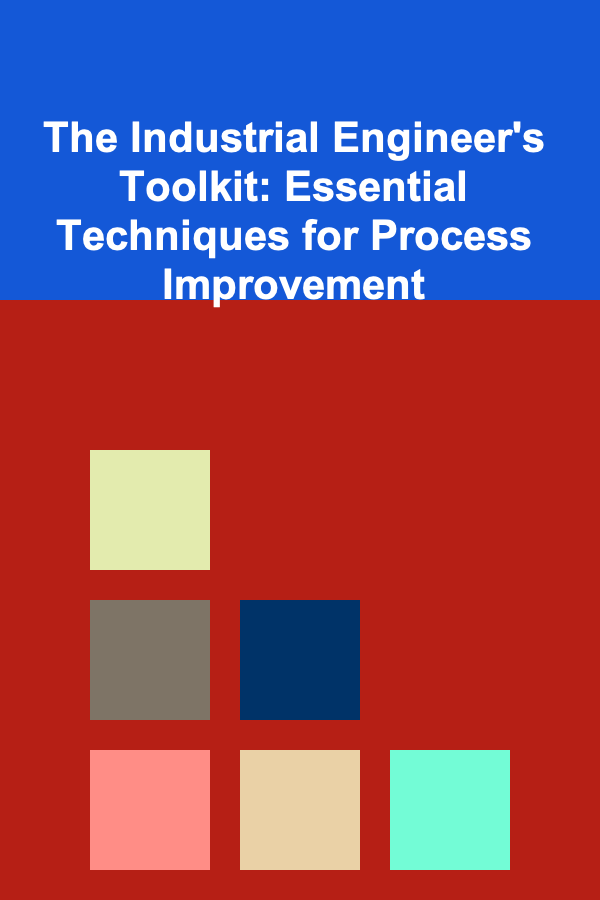
The Industrial Engineer's Toolkit: Essential Techniques for Process Improvement
ebook include PDF & Audio bundle (Micro Guide)
$12.99$8.99
Limited Time Offer! Order within the next:

Industrial engineers are at the forefront of optimizing systems, processes, and workflows in a wide range of industries. By focusing on improving efficiency, reducing waste, and increasing productivity, industrial engineers play a crucial role in the success of organizations. To effectively carry out these responsibilities, they rely on a robust set of tools and techniques that guide their decision-making and problem-solving.
In this actionable guide, we will explore the most essential techniques in the industrial engineer's toolkit for process improvement. These techniques have been proven across various industries and can be applied in any organization seeking to streamline its operations, enhance productivity, and maintain high-quality standards.
Lean Principles: Streamlining Processes by Eliminating Waste
Lean manufacturing is one of the most widely used frameworks in industrial engineering, focused on eliminating waste and maximizing value for the customer. Waste is defined as anything that does not add value to the product or service. By eliminating these inefficiencies, organizations can improve process flow, reduce costs, and increase the overall productivity of their operations.
Key Lean Tools
Value Stream Mapping (VSM)
Value stream mapping is a tool used to analyze the flow of materials and information in a process. It helps identify areas of waste and inefficiency, such as bottlenecks, excess inventory, and unnecessary steps in the production cycle. By mapping out the current state of a process and envisioning a future state, engineers can design more efficient systems that minimize waste.
5S System
The 5S system is a methodology used to organize and standardize the workplace. It consists of five principles:
- Sort: Eliminate unnecessary items from the workspace.
- Set in Order: Organize tools and materials to make them easy to access.
- Shine: Clean the workspace to ensure safety and efficiency.
- Standardize: Develop consistent procedures for maintaining organization.
- Sustain: Regularly audit the system to maintain cleanliness and organization.
The 5S system helps to reduce time wasted searching for tools, materials, and information, resulting in improved efficiency and reduced errors.
Kaizen (Continuous Improvement)
Kaizen is a philosophy of continuous, incremental improvement. The core idea is that small, consistent improvements over time can lead to significant long-term gains in productivity and quality. Kaizen promotes employee involvement in the improvement process, encouraging workers at all levels to suggest ideas and implement changes that improve efficiency.
Lean Manufacturing's Impact
When Lean principles are applied effectively, they result in a more streamlined production process with fewer delays, better resource utilization, and improved product quality. By continuously eliminating waste and focusing on value, organizations can respond more quickly to customer demands and market changes, leading to higher satisfaction and reduced costs.
Six Sigma: Reducing Variability and Defects
Six Sigma is a data-driven methodology aimed at improving the quality of a process by identifying and reducing variability and defects. The term "Six Sigma" refers to achieving a level of process performance where the likelihood of defects is minimal (3.4 defects per million opportunities).
Key Six Sigma Tools
DMAIC (Define, Measure, Analyze, Improve, Control)
DMAIC is the structured approach used in Six Sigma for improving existing processes. Each phase of DMAIC focuses on a different aspect of the process:
- Define: Identify the problem, set objectives, and define the project scope.
- Measure: Collect data to understand the current process performance.
- Analyze: Identify root causes of defects and variability using statistical tools.
- Improve: Implement solutions to address the root causes and optimize the process.
- Control: Establish controls to maintain improvements and ensure long-term success.
Statistical Process Control (SPC)
SPC is a tool used to monitor and control the quality of a process through statistical methods. By using control charts and other visual tools, industrial engineers can detect when a process is deviating from its target performance, allowing for corrective action before defects occur.
Design of Experiments (DOE)
Design of Experiments is a structured method used to plan and analyze controlled tests in a process. It helps identify relationships between different process variables and their effects on product quality. By systematically testing changes in variables, engineers can determine the optimal settings for a process to reduce defects and maximize performance.
Six Sigma's Impact
Six Sigma improves quality by focusing on reducing variation in processes. It enables organizations to deliver consistent, high-quality products and services that meet customer expectations. With its reliance on data and statistical analysis, Six Sigma minimizes the risk of defects and maximizes efficiency.
Total Quality Management (TQM): A Holistic Approach to Quality
Total Quality Management (TQM) is an organization-wide approach to improving the quality of products and services. TQM involves every department and employee, from top management to front-line workers, in efforts to continually improve processes, products, and customer satisfaction.
Key TQM Principles
Customer Focus
A central tenet of TQM is that every process and improvement effort should be aligned with meeting or exceeding customer needs and expectations. By focusing on customer satisfaction, organizations can drive improvements that have a direct impact on the quality and value of their offerings.
Employee Involvement
TQM encourages the active participation of all employees in quality improvement activities. Workers on the shop floor are often the best positioned to identify inefficiencies and suggest solutions, and TQM promotes a culture of open communication and collaboration across all levels of the organization.
Process Approach
TQM emphasizes the importance of viewing an organization as a set of interconnected processes. By optimizing these processes and focusing on continuous improvement, businesses can ensure that they are delivering quality at every stage of production or service delivery.
Data-Driven Decision Making
TQM requires organizations to base their decisions on objective data rather than intuition or guesswork. This ensures that improvements are based on facts, not assumptions, and that quality initiatives are measurable and verifiable.
TQM's Impact
TQM's holistic approach to quality leads to greater consistency, better customer satisfaction, and enhanced organizational performance. By involving every employee in the process and focusing on continuous improvement, TQM fosters a culture of excellence that can lead to long-term success.
Root Cause Analysis: Identifying and Solving Problems at the Source
Root Cause Analysis (RCA) is a systematic method for identifying the underlying causes of problems or failures in a process. Instead of merely addressing symptoms, RCA seeks to find the root cause and implement corrective actions that eliminate the issue permanently.
Key RCA Techniques
The 5 Whys
The 5 Whys technique is a simple yet powerful tool for root cause analysis. By asking "Why?" repeatedly (usually five times), industrial engineers can trace a problem back to its origin. This method helps to identify the fundamental cause of an issue, rather than just dealing with its surface-level effects.
Fishbone Diagram (Ishikawa Diagram)
The Fishbone Diagram, also known as the Ishikawa Diagram, is a visual tool that categorizes potential causes of problems. It is often used in team-based problem-solving sessions and helps to identify factors such as equipment, materials, methods, and personnel that contribute to defects or inefficiencies.
Failure Mode and Effect Analysis (FMEA)
FMEA is a proactive tool used to identify potential failure modes in a process before they occur. It assesses the severity, likelihood, and detectability of each potential failure and prioritizes them for corrective action. FMEA helps prevent issues from arising by addressing them during the design or planning stages.
RCA's Impact
Root Cause Analysis helps organizations move beyond temporary fixes and address the source of recurring problems. By identifying and eliminating the root cause, engineers can implement solutions that lead to sustainable improvements in processes, quality, and performance.
Automation and Technology Integration: Enhancing Efficiency through Innovation
The integration of automation and modern technologies is a key enabler of process improvement. Industrial engineers are increasingly leveraging tools such as robotics, AI, IoT, and data analytics to optimize production and service processes.
Key Technologies
Robotics and Automation
Robots can perform repetitive and labor-intensive tasks with high precision and speed, reducing the reliance on manual labor and minimizing human error. Automation increases throughput and consistency, improving both productivity and quality.
Internet of Things (IoT)
IoT involves using connected devices and sensors to monitor and control processes in real-time. IoT enables engineers to gather data on machine performance, environmental conditions, and product quality, allowing for quicker decision-making and predictive maintenance.
Artificial Intelligence (AI)
AI and machine learning algorithms can be used to optimize complex processes by identifying patterns and making real-time adjustments. AI can improve decision-making, predict failures, and enhance quality control, leading to more efficient and responsive operations.
Impact of Technology
The integration of technology drives significant improvements in process efficiency, data accuracy, and product quality. Automation reduces human error, while AI and IoT allow for real-time optimization and predictive maintenance, minimizing downtime and enhancing operational performance.
Conclusion
Industrial engineers have a vast toolkit of proven techniques to drive process improvements and optimize organizational performance. From Lean principles that eliminate waste to Six Sigma's focus on reducing defects, these methodologies empower engineers to enhance productivity, improve quality, and streamline operations. By combining traditional approaches such as Total Quality Management with modern technologies like automation and AI, industrial engineers can lead organizations toward greater efficiency and long-term success.
By mastering these tools and techniques, industrial engineers are well-equipped to tackle complex challenges, implement effective solutions, and create lasting improvements that provide measurable value to businesses and their customers.

How to Create a Family Communication Plan with Your Kit
Read More
How to Invest in Foreign Currencies for Currency Diversification
Read More
How to Keep Your Guests Entertained at a Home Party
Read More
How to Organize a Family Book Club for Kids and Adults
Read More
How to Organize Space-Saving Toy Storage Ideas for Kids' Rooms
Read More
How to Use Meditation Guidance to Make Money
Read MoreOther Products

How to Create a Family Communication Plan with Your Kit
Read More
How to Invest in Foreign Currencies for Currency Diversification
Read More
How to Keep Your Guests Entertained at a Home Party
Read More
How to Organize a Family Book Club for Kids and Adults
Read More
How to Organize Space-Saving Toy Storage Ideas for Kids' Rooms
Read More